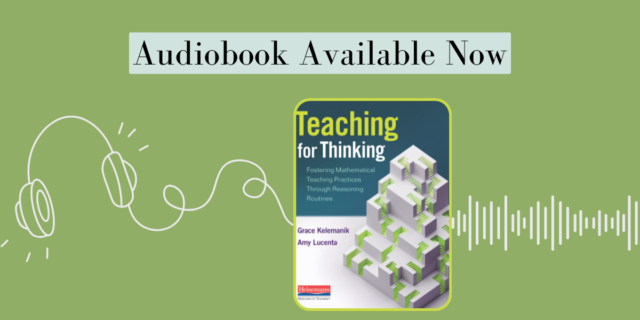
This month, we look at ways to infuse concepts of community in the math classroom to support confidence and participation.
♦ ♦ ♦ ♦
by Jaclyn Karabinas
Connect
Think about something that challenges you to think through carefully and describe clearly to others. Can you name the reasons why this challenges or frustrates you? Does it help you to refer to visuals or confer with a friend or colleague?
![]() Consider
Consider
As we work through understanding the role of communication in math classrooms, our guiding question is: How do we foster a learning community where explanations take center stage so our students experience mathematics as communication vs. right answers?
![]() Educate
Educate
In this video blog, Routines for Reasoning co-author Grace Kelemanik talks about how to move mathematics conversations away from the answer by rephrasing questioning. As you watch, jot down some of her suggestions.
![]() Reflect
Reflect
In her book, Teaching Talk: A Practical Guide to Fostering Student Thinking and Conversation, Kara Pranikoff says, “Conversation is the currency for most ideas in the world.” How can conversations among students not only help them to see themselves as mathematicians, but provide you with valuable information about what students know (or think they know)?
![]()
Practice
Just as we can be metacognitive about our processes as readers and writers to break down instructional strategies into “actionable steps” (as Jennifer Serravallo describes them), we can examine our own ways of thinking mathematically to practice noticing what pieces of information led us to an answer and why. When students share what they notice and and how they knew to do this, they can learn from each other’s processes instead of shutting down because they didn’t get the answer quickly.
Look at these two examples below. Once you view them and determine your answer, can you slow down and rewind your thinking to describe what you looked at, when, why, and how that built your answer? Find a colleague to do this with. Each of you write down your process, read it aloud to one another, and use this as a conversational starting point.
- 47 + ? = 51
- What type of triangle is this?

![]()
Extend
Watch this classroom clip with Math in Practice author Sue O’Connell for an example of what this looks like when the emphasis is on the conversation about thinking processes over the answer to the word problem itself.
![]() Refine
Refine
In this piece by Steve Leinwand, Just Ask Them "Why?", we have a chance to hear his thinking behind why not asking “Why?” is such a missed opportunity. He notes that regularly asking for explanations “conveys the expectation that students can learn from each other as well as from their teachers and thereby helps to build an effective classroom community of learners.”
![]() Act
Act
In your math instruction this week, intentionally include modeling of thinking processes, asking why, and focusing on students’ talk to begin and end each lesson. Be sure to emphasize—and celebrate—conversation over correct answers as you check in with students during their practice time.
>>>For Further Reading:


